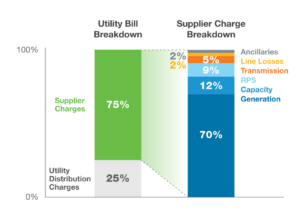Make targeted adjustments to energy usage during peak hours to reduce energy costs
In general, the charges on your utility bill fall into one of two categories, demand based charges and usage based charges.
In most cases, demand-based charges are included as a part of your utility distribution costs on your utility bill. Typically, these charges are based on your peak demand during any hour of the billing cycle on your electricity bill. In order to manage these demand-based costs, it is important to understand what operations and systems are contributing to your consumption during peak demand periods. With this understanding, you may be able to take actions that will reduce your peak demand, such as reducing your lighting and air conditioning load for short periods, and as a result, lower your peak demand-based charges on your utility and/or energy supply bills.
What you use this year on the peak day(s) will become your future capacity tag assignment. Just one hour of high energy usage during the year can lead to higher bills the following year. Usource works with clients to predict when these peak demand hours occur. By making targeted adjustments to energy usage during these hours, you can significantly reduce costs.
Do you know your capacity tag charges?
Request your custom capacity tag analysis now
Understanding capacity charges
Your total electricity charge is made up of several individual costs: some controllable, others not. On your utility bill, you will notice a utility distribution charge and a supplier charge. The distribution charge paid to your utility accounts for roughly 25% of your total electricity cost and cannot be changed. The remaining 75%, your supplier charge, includes cost components, such as the actual generation cost of the electricity, capacity, transmission, and other smaller charges.

The capacity charge is one cost that can be affected with proper management. Your capacity charge is made up of two main components: capacity cost and capacity tag.
Capacity cost
Capacity tag


